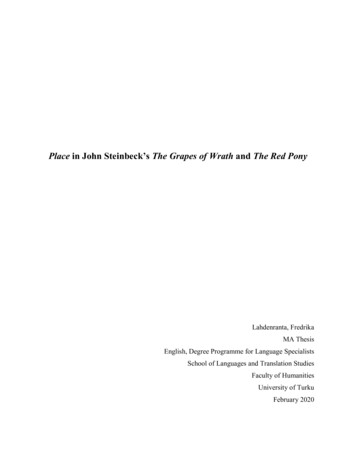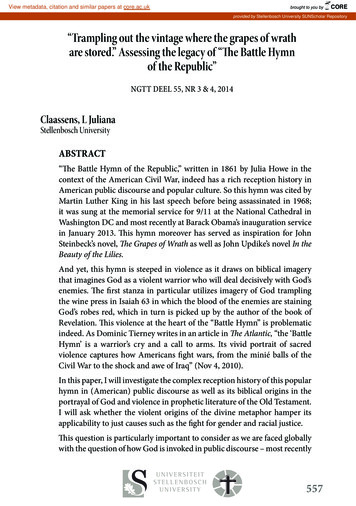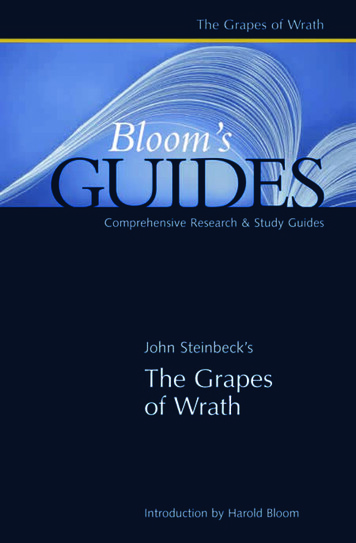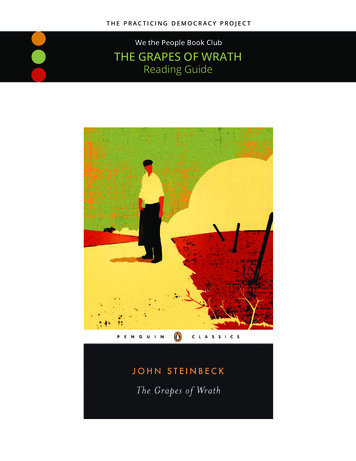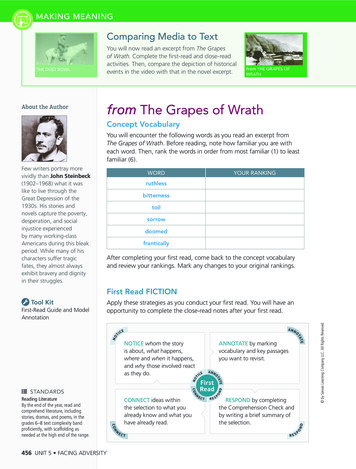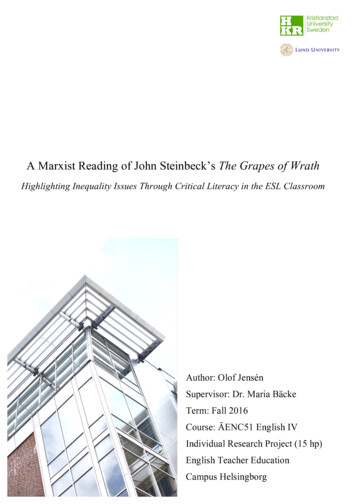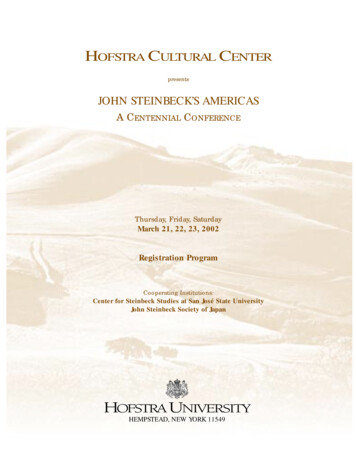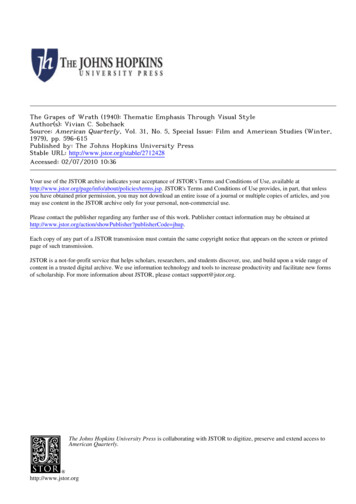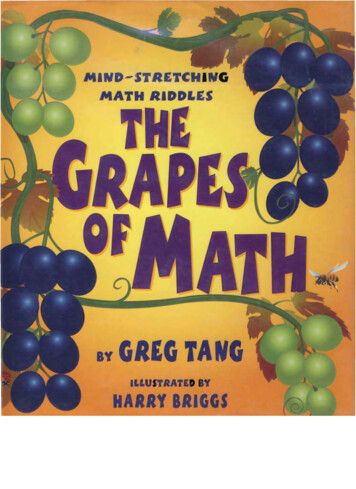
Transcription
SamplePrestwick HouseMultiple CriticalPerspectives Prestwick HouseTeaching John Steinbeck’sThe Grapes of WrathfromMultiple Critical Perspectives Click hereto learn moreabout thisMultiple CriticalPerspectives! Click hereto find moreClassroom Resourcesfor this title! Prestwick HouseMore from Prestwick HouseLiteratureLiterary Touchstone ClassicsLiterature Teaching UnitsGrammar and WritingCollege and Career Readiness: WritingGrammar for WritingVocabularyVocabulary Power PlusVocabulary from Latin and Greek RootsReadingReading Informational TextsReading Literature
Multiple CriticalPerspectivesTeaching John Steinbeck'sThe Grapes of WrathfromMultiple Critical Perspectives byEva Richardson
Multiple CriticalPerspectivesThe Grapes of WrathGeneral Introduction to the WorkIntroduction to The Grapes of WrathTheGrapes of Wrath is a novel relating the experiences of disenfranchised migrant farmers escapingAmerica’s Dust Bowl region in search of a new life in California during the 1930s. The novel incor-porates elements of the historical novel.All novels rely on certain conventional elements, including plot. (In an attempt to escape theecological disaster of the American Dust Bowl, the Joad family of Oklahoma sets out for California inhopes of finding work and a new life. Once on the road, the Joads realize that there are thousands ofmigrant farmers who, like themselves, have been driven off their land and are now traveling toward the“Promised Land” of California. The Joad family endures considerable hardship while on the road. Oncethey reach California, they learn that there is not enough work for all the migrant farmers. Moving fromcamp to camp, the Joads realize that the working conditions in California are harsh, and they struggle tokeep their family alive.)Character is another crucial element of the novel. (The Joad family stands at the center of The Grapesof Wrath. Tom Joad is one of the major characters, and his psychological and spiritual development iscentral to the text. Tom can be considered a dynamic character because he changes over the courseof the novel as a result of his experiences narrated in the plot. Ma Joad is another essential, dynamiccharacter. Within the Joad family, she quickly emerges as the leader. The other Joad family members, PaJoad, Grampa and Granma, Al, Noah, Rose of Sharon, Connie, and the children Ruthie and Winfield, allenable Steinbeck to vividly illustrate the difficult life Dust Bowl refugees had to endure. Other charactersin the novel include the preacher Jim Casy, who functions as a symbolic character, the Wilson family,law enforcement officials, and as camp personnel. The structure of the novel indicates that the Joads areexemplary of thousands of, anonymous families who underwent similar experiences during the 1930s.)Another significant element of the novel is setting, the time and place in which the characters moveand the plot events take place. (The Grapes of Wrath is set in America during the 1930s. During that timeperiod, Americans suffered from the effects of the Great Depression, a time of severe economic crisis.Additionally, most Americans—particularly farming families in Great Plains states such as Oklahoma—struggled to escape the effects of the Dust Bowl, a period of devastating dust storms caused by improperagricultural techniques and a severe drought that affected the farming regions of the American Mid-west.The plot of the novel begins in Oklahoma, where the Joads are forced to leave their land. The family thentravels along Route 66 to California.)6Pr e s t w i c kHo u s e,In c.
The Grapes of WrathMultiple CriticalPerspectivesMythological/ArchetypalApplied to The Grapes of WrathNotes on the Mythological/Archetypal ApproachMythological, archetypal, and psychological criticismare allvery closely interrelated. This is because Freud formulatedmany theories around the idea of the social archetype; and his pupil,Carl Jung, expanded and refined Freud’s theories into a more crosscultural philosophy.Critics who read texts with the mythological/archetypal approachare looking for symbols. Jung said that an archetype is “a figure.thatrepeats itself in the course of history wherever creative fantasy isfully manifested.” He believed that human beings were born innatelyknowing certain archetypes. The evidence of this, Jung claimed,lay in the fact that some myths are repeated throughout history incultures and eras that could not possibly have had any contact withone another. Many stories in Greek and Roman mythology hadcounterparts in Chinese and Celtic mythology long before the Greekand Roman Empires spread to Asia and northern Europe. Most ofthe myths and symbols represent ideas that human beings couldnot otherwise explain (the origins of life, what happens after death,etc.) Every culture has a creation story, a life-after-death belief, andan explanation for human failings, and these stories—when studiedcomparatively—are far more similar than different.When reading a work looking for archetypes or myths, criticslook for very general recurring themes, characters, and situations. Inmodern times, the same types of archetypes are used in film, whichis why it has been so easy for filmmakers to take a work like JaneAusten’s Emma and adapt it into the typical Hollywood film Clueless.By drawing on those feelings, thoughts, concerns, and issues thathave been a part of the human condition in every generation, modern authors allow readers to know the characters in a work with littleor no explanation. Imagine how cluttered stories would be if theauthor had to give every detail about every single minor characterthat entered the work!Pr e s t w i c kHo u s e,In c.19
The Grapes of WrathMultiple CriticalPerspectivesActivity OneExamining Tom Joad and Jim Casy as Archetypal Characters1. Divide the class into pairs or small groups. Assign two groups to review each of the followingChapters: 2, 4, 8, 10, 20, 27, and 29.2. For each chapter, ask one group to review and take detailed notes on the character of Tom Joad.Ask the other group to review and take detailed notes on the character of Jim Casy. Each groupshould pay particular attention to references to qualities of the archetypal HERO and/or archetypalOUTCAST. Each group should present relevant information about their character as it relates to thearchetypal HERO or OUTCAST to the class.3. Use the following questions to generate a classroom discussion in which you ask students to relatetheir notes about Jim Casy and Tom Joad with regard to the qualities and characteristics of the archetypal hero and/or outcast: What elements in the novel make Tom Joad an outcast? What elements of the novel make Jim Casy an outcast? What is the significance of both characters’ shared prison experience? What do both characters learn in the course of their imprisonment? What is the relationship between hero and sacrifice for Jim Casy and Tom Joad? To what extent does Jim Casy emerge as a leader? What heroic qualities does he exemplify? To what extent does Tom Joad emerge as a leader? What heroic qualities does he exemplify? What does Jim Casy’s dissatisfaction with institutionalized religion reveal about his definitionof a hero or his role as a hero? How do the journey and ultimate fate of Jim Casy reflect the typical fate of the archetypal heroand/or outcast? How do the journey and ultimate fate of Tom Joad reflect the typical fate of the archetypal heroand/or outcast? To what extent are both characters dependent on one another for their personal development?Pr e s t w i c kHo u s e,In c.23
The Grapes of WrathMultiple CriticalPerspectivesFeminist Approach Appliedto The Grapes of WrathNotes on the Feminist ApproachFeminism is an evolving philosophy,and feminism in literatureis an even newer area of study and thought. The basis of themovement, both in literature and society, is that the Western worldis fundamentally patriarchal (i.e., created by men, ruled by men,viewed through the eyes of men, and judged by men).The social movement of feminism found its approach to literature in the 1960s. Of course, women had already been writing andpublishing for centuries, but the 1960s saw the rise of a literary theory. Until then, the works of female writers (or works about females)were examined by the same standards as those of male writers (andabout men). Women were thought to be unintelligent (at least inpart because they were generally less formally educated than men),and many women accepted that judgment. It was not until the feminist movement was well under way that women began examining oldtexts to reevaluate their portrayal of women and writing new worksto fit the “modern woman.”Three main areas of study/points of criticism: differences between men and women women in power or power relationships between men and women the female experiencePr e s t w i c kHo u s e,In c.27
Multiple CriticalPerspectivesThe Grapes of WrathActivity OneExamining the Power Hierarchy in the Relationship Between Ma and Pa Joad1. Divide the class into four groups or a number of groups divisible by four. Assign each group (orallow each to choose) one of the following passages. Have students review the entire chapter, butpay particular attention to the sections indicated here: Chapter 8 – paying particular attention to descriptions of Ma following Tom’s return from prison Chapter 10 – paying particular attention to Ma’s participation in the discussion about Jim Casy andhis desire to join the family on their journey to California Chapter 16 – paying particular attention to Ma’s actions, decisions, and demeanor following thebreakdown of the Wilsons’ car Chapter 28 – paying particular attention to Ma’s conversations following her decision to send Tominto hiding2.Each group should examine the assigned passages carefully and take detailed notes.3.Use the following questions to generate a classroom discussion: What female stereotypes, if any, does Ma Joad exhibit in the early chapters of the novel? Who are the dominant characters in the Joad family? In what ways are they dominant? What role does Ma Joad play in each assigned chapter? Leader? Supporter? Subservient? Equal? How does Pa Joad treat Ma Joad in each of the assigned chapters? Does his treatment of Ma changethroughout the novel? Does Ma Joad’s attitude toward the relationship between men and women change during thecourse of the assigned chapters? If so, how? How can Ma Joad’s attitude toward Pa be characterized? To what extent does the Joad marriage represent a patriarchal, or traditional marriage? How doesit divert from a patriarchal, or traditional marriage?32Pr e s t w i c kHo u s e,In c.
The Grapes of WrathMultiple CriticalPerspectivesNew Historicism Appliedto The Grapes of WrathNotes on New HistoricismAcommon tendency in the studyof literature written in, and/orset in, a past or foreign culture is to assume a direct comparisonbetween the culture as presented in the text and as that culture reallywas/is. New Historicism asserts that such a comparison is impossiblefor two basic reasons.First, the “truth” of a foreign or past culture can never be knownas established and unchangeable. At best, any understanding of the“truth” is a matter of interpretation on the parts of both the writerand the reader. This is most blatantly evident in the fact that the “losers” of history hardly ever get heard. The culture that is dominatedby another is often lost to history because it is the powerful whohave the resources to record that history. Even in recent past events,who really knows both sides of the story? Who really knows thewhole of the Nazi story? Or the Iraqi story? New Historicists arguethat these unknown histories are just as significant as the historiesof the dominant culture and should be included in any world view.Since they often contradict “traditional” (i.e., the winner’s) history,there is no way to really know the ironclad truth.Second, while the text under consideration does indeed reflectthe culture in which it was written (and to some degree in whichit is set), it also participates in the culture in which it is written.In other words, its very existence changes the culture it “reflects.”To New Historicists, literature and culture are born of one another.For example, although Harper Lee’s To Kill a Mockingbird certainlyreflected the culture of the south during the mid-20th century, it alsobecame a tool to raise awareness of and change certain elements ofthat culture.Pr e s t w i c kHo u s e,In c.37
The Grapes of WrathMultiple CriticalPerspectivesActivity OneExamining the Text for Clues to the Economic and Social Situation in the United StatesDuring the 1930s1.Copy and distribute: The Grapes of Wrath: New Historicism—Activity One.2.Then have students (individually, in pairs, or in small groups) answer the following questions: What view of the Great Depression is portrayed in The Grapes of Wrath? Whose perspective ofevents is illustrated throughout the novel? Do we see events from different perspectives? Why orwhy not? What view of the Dust Bowl is portrayed in The Grapes of Wrath? Whose perspective of eventsis illustrated throughout the novel? Do we see events from different perspectives? Why or whynot? What events or consequences of the Great Depression or the Dust Bowl does the novel primarilyfocus on and why? Does the novel effectively present the plight of all American farmers affected by the GreatDepression and the Dust Bowl? Why or why not? How do the events of the 1930s affect Steinbeck’s creation of the character of Jim Casy? In order to reach his intended audience or achieve his intended goal, what changes might Steinbeckhave had to make with regard to events relating to the Great Depression or the Dust Bowl? How does Steinbeck portray the landowners in Oklahoma and California?Pr e s t w i c kHo u s e,In c.41
6 P r e s t w i c k Ho u s e, in c. Multiple Critical Perspectives The Grapes of Wrath General Introduction to the Work Introduction to The Grapes of Wrath T he Grapes of Wr at h is a novel relating the experiences of disenfranchised migrant farmers escaping America’s Dust Bowl regio
